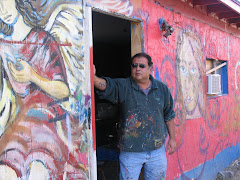Mirror on the Wall
Society sees its reflection in David Tineo's murals.
By CRISTIÁN A. SIERRA
The beauty of any interest in mural making is that it is accessible. It is a means of expression in public view," says longtime Tucson muralist and Pima Community College art professor David Tineo. "Murals promote heritage." At the August 25 Fiesta de San Agustín at Armory Park, Tineo will discuss his ideas and art, and field questions from the audience along with other speakers who will take the stage on various topics between 1 and 4 p.m.
Tineo says he wasn't influenced by the Mexican muralists' politics "but by the impact of art for the people. Art should be accessible to anyone. The reason I lean towards the Mexican muralists is their context of taking everyday common imagery as far as la raza indígena [the indigenous people] and communicating that as an art form to the world."
Muralismo is about public works, "which goes back to los tres de Mexico," says Tineo, referring to the three greats of the Mexican muralist movement: Diego Rivera, David Alfaro Siqueiros and José Clemente Orozco.
Since the late '70s Tineo has been putting his paint brush where his heart is, beautifying everything from the walls of commercial spaces such as El Charro Café to the north wall of the Tucson Museum of Art, as well as painting on canvases and working with children at Holcolm Middle School.
"You take an art form which is mural making and you get [kids] to express themselves and redirect those energies to get them talking about issues and things about themselves, what's important for them," says Tineo. "Public art or mural art is an act of empowerment. It acts as a catalyst for learning and expression and participation."
Tineo describes his work as "del corazón" [from the heart] and "espejo del publico" [a mirror of society]. Though he does do easel work, Tineo prefers the collaborative process and exposure of the mural, although he admits mural work isn't lucrative and when a building is sold, persuading the new owner to keep the mural is sometimes a challenge.
"Sometimes we face a dilemma of durability as soon as that building is bought by a new owner," he says. "Hopefully we convince the new owners to keep that mural. The mural is a viable part of that community. It is the very lifeblood of that community. But the key here is to involve the community. It's not individual expression. It's a group collaboration of ideas, hopes, dreams and insights. [The muralists] are just the catalysts. We direct and coordinate as artists and pull together those concepts into some kind of format that communicates the hopes of the people."
But murals haven't gotten the respect they deserve as an art form, says Tineo. "In the '70s and '80s a lot of what we did wasn't considered art. It was considered more of a folk style and not accepted as a valid art form ... [but] the only voice we had [during the Chicano movement of the '60s and '70s] was the art. We didn't have the political power we have now. That was how we got our message across: through the music, the art and the Teatro Campesino [a Chicano theatrical troop founded on the picketing lines of the Delano grape strike in 1965].
"I've always been fighting for [murals] because the first form of art was a mural. Cave paintings in Altamira, Spain [show] it was the artist that empowered the clan to succeed in the hunt. It wasn't after the fact. It was before. They envisioned success, they portrayed a successful hunt," says Tineo, who sees mural art in this way empowering an entire community. "Murals are just as important as easels, even more so because it is the marriage of artist and community: The murals being the children."
But fighting for one's individual means of expression isn't new to Tineo, who grew up in Barrio Anita in the 1950s and early '60s and was put into special education along with others who refused to speak English. "There was no acceptance or acknowledgement of bilingual education," he says. "We weren't allowed to speak Spanish. ... You were punished for speaking Spanish." Now he is in those same schools, working with children to express themselves through mural making.
As for future projects, Tineo still works closely with Raíces Taller 222 Art Gallery and Workshop, a local Chicano arts organization that will be showing some of Tineo's canvases in an upcoming Politics, Religion and Arts show. Tineo will also do a lecture series with the Tucson Museum of Art for Día de los Muertos in late October and early November to promote Mexican heritage and culture
Saturday, September 29, 2007
Subscribe to:
Post Comments (Atom)

No comments:
Post a Comment